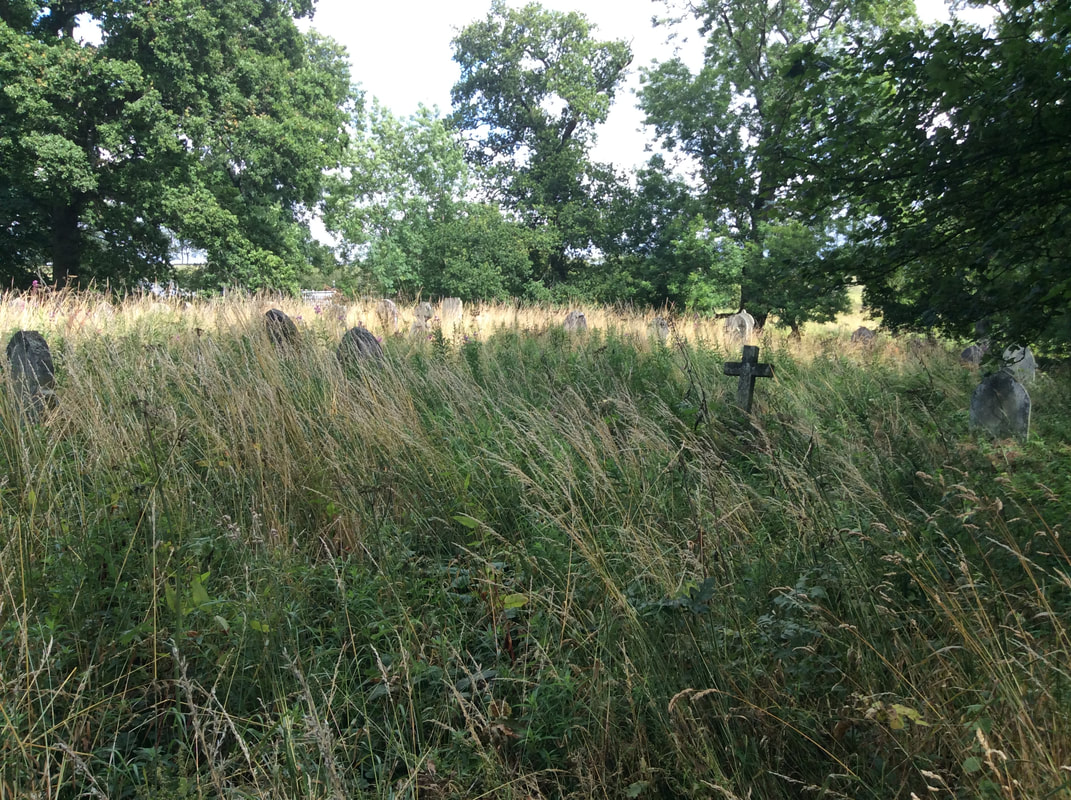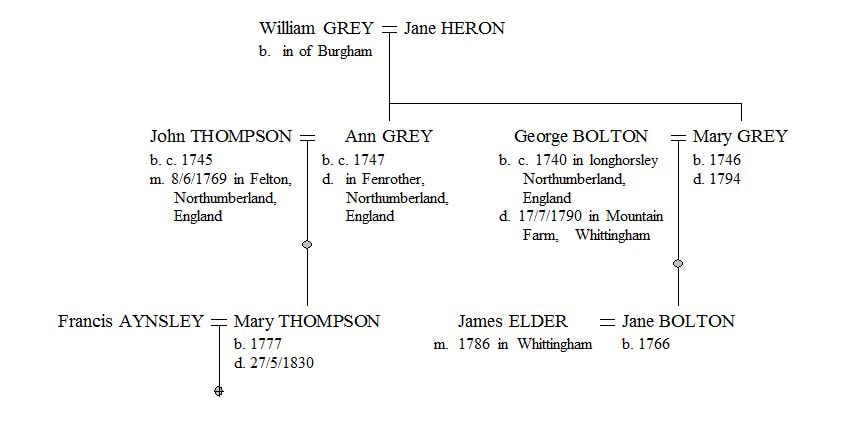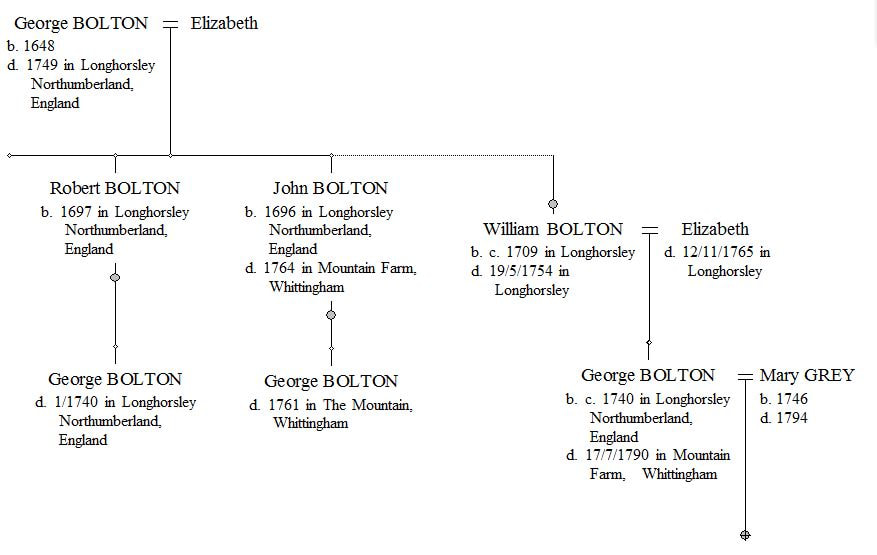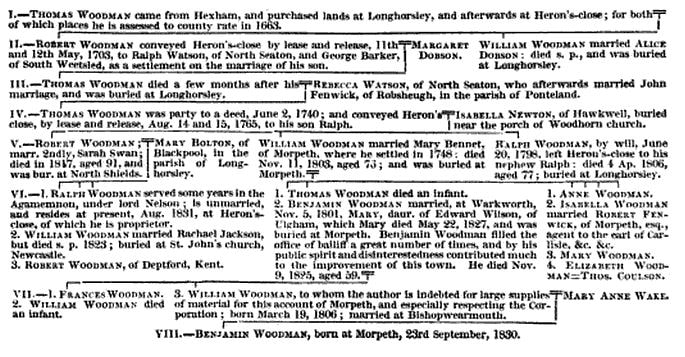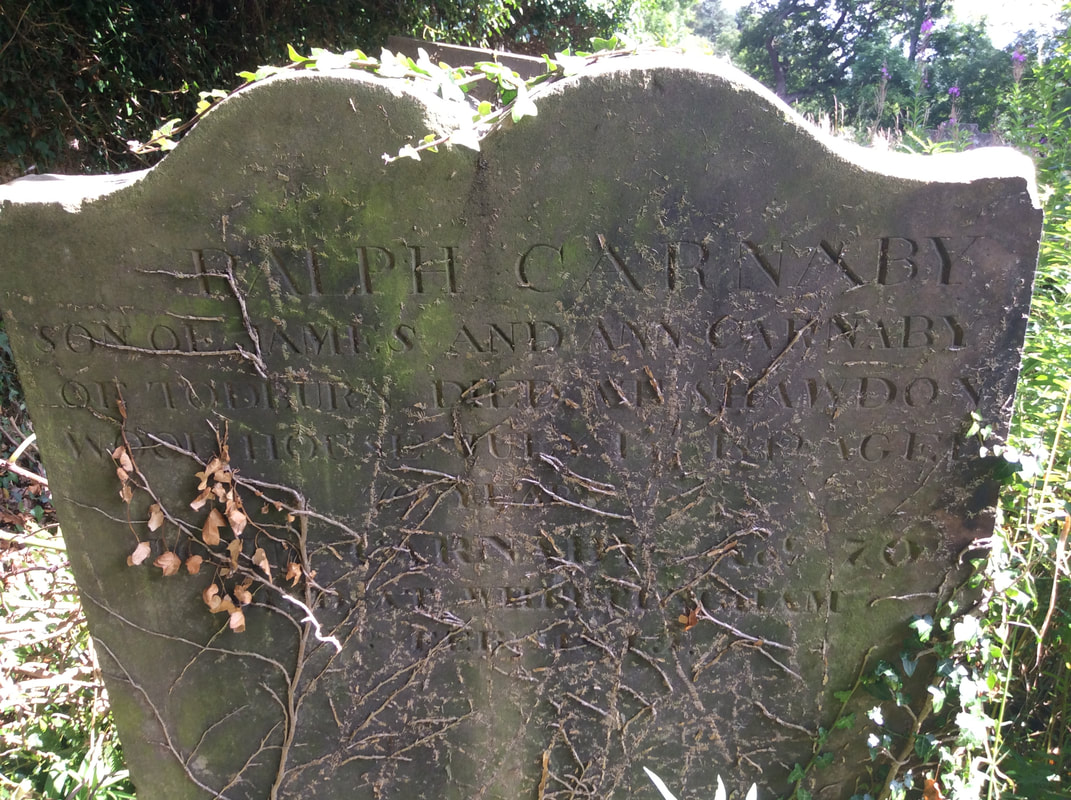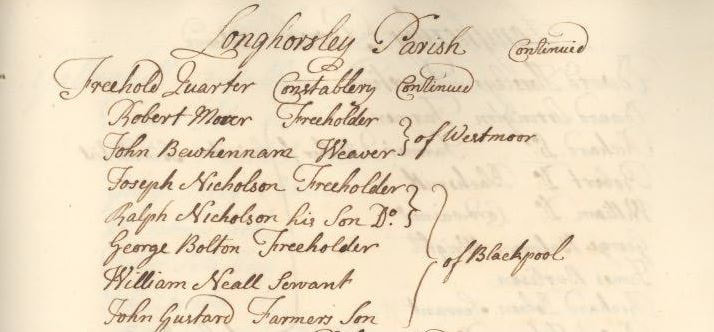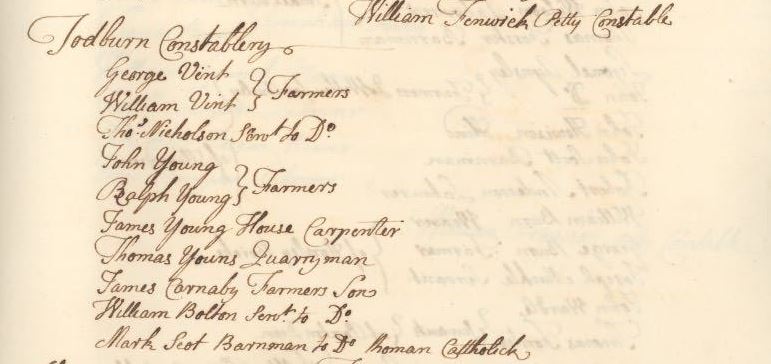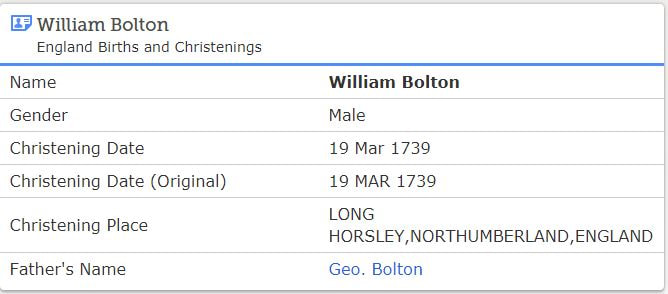|
It was my intention to write this month’s blog about the contents of Mary Thompson’s letter of 1796 and it was whilst sorting out ‘who was who’ in order to add to Philip Aynsley-Smith’s notes that I disappeared down a rabbit hole. The cause was initially the mention of a Mrs Elder – was this her 1st cousin Jane Bolton who had married James Elder of Alnwick, at Whittingham in July 1786? Jane Bolton’s Mother was Mary Grey, sister to Ann Grey, the mother of Mary the letter writer. Looking at the Bolton pedigree as compiled by George Aynsley – Smith (1866-1942, hereafter referred to as GAS to save confusion), the research of which, it is stated, formed the basis of a published pedigree some 30 years after his death. "The Bolton Family from Northumberland and its Connections. A record of Kinship" , by A. R. C. Bolton dated 28th February 1971 is stored at the Society of Genealogists in London. A typed manuscript of 24 pages, (reference number : Family History Tracts Vol 112,) the author writes that his knowledge of the Bolton pedigree came from the work of G. Aynsley Smith.... Needless to say the pedigree that was attached has long since disappeared, hence the requirement to reconstruct the pedigree as drafted by GAS. I wonder if A R C Bolton corresponded with George’s son Philip? If so then it will undoubtedly have survived and may shed some light on the issue which saw the rabbit hole I had fallen down, rapidly become a warren. In the pedigree GAS has attributed the parentage of George Bolton to a William Bolton of Blackpool and his wife Elizabeth, not to Robert Bolton and Elizabeth Davison as recorded in several other well researched family trees. He notes George Bolton (son of Robert) as buried at Longhorsley 24th January 1740. However, a quick search brings this record up as a baptism not a burial at all! Is this then an error on the part of George Aynsley – Smith or, is it a burial that has been entered incorrectly under baptisms in the Longhorsely register? Without sight of the original register I am unable to tell – the Bishop's Transcripts alas do not extend that far back. On the basis that there is usually more than one way ‘to skin a cat’ a little lateral thought was required. In the pedigree George Bolton of Blackpool had a sister Mary who married Robert Woodman of Herons Close at Hebron in 1757. Hodgson’s History of Northumberland states she was ‘of Blackpool’ but alas does not cite the source of this information. The online trees have attributed a baptism in Morpeth on 11th October 1739 to the Mary Bolton who married Robert Woodman, which I suspect may be incorrect. Although this Mary would be old enough (18), from other baptisms in the Morpeth register she may also possibly be the Mary born to a Robert Bolton that was baptised in Morpeth in 1734. There was certainly more than one Robert Bolton baptising children in Morpeth at this time. One was a Robert Bolton and Margaret Thomson who married at Mitford in 1724:
Who it appears may have been previously married to an Elizabeth Sanderson in 1712
With Robert Bolton who Married Elizabeth Davison at Hebron in 1730 added to the mix as other potential parents of:
The two baptisms which do appear in the Longhorsley register are definitely children of a Robert Bolton, but is it the Robert Bolton who married Elizabeth Davison at Hebron in 1730?
Furthermore, is this George, the George Bolton of Blackpool? Knowing the vageries of the old parish registers combined with the fact that Longhorsley was a hotbed of recusancy and jacobitism in the early eighteenth century I still have doubts. Particularly as the Bolton family had known associations with such families as the Carnabys for whom few records have survived for this very reason. There were obviously several Bolton families in and around Longhorsley and Morpeth at this time and to unpick them all will take a bit of time. My inclination, as yet unproven, is that many of these Robert Boltons’ descend from the Fenrother (in the chapelry of Hebburn aka Hebron) branch, and a Robert Bolton who died there and left a will in 1612/13. This would in some way account for the marriages at Hebron in the eighteenth century, which in turn casts doubt over Hodgson’s uncited reference to Mary Bolton, and her designation as ‘of Blackpool’ and a sister of George Bolton. However, for the Bolton family linked to Mrs Elder in the letter the one constant and common denominator throughout IS Blackpool Farm. A John Bolton bought Blackpool Farm from John Ogle on 28th July 1600. ‘...after which is passed through several generations of the Bolton family until Charles William Bigge purchased it in 1823 … George Bolton who owned the farm in 1664 was one of Longhorsley’s more substantial landowners …Unfortunately the current farmstead is nineteenth century in date and so does not provide physical evidence that might determine its origins. It is a substantial farm and has ornamental aspects, as its hedgerows contain sycamores, which are unknown elsewhere in Longhorsley’ I suspect the will of 1688 is that of the above mentioned George Bolton of Longhorsley, the owner in 1664 and either a son or grandson of the original purchaser. In his will he names his eldest son as George, thus following the traditional naming pattern. His second son is John who inherited Hedley Wood and then James and then William. There is no mention of his wife who had presumably predeceased him and certainly no mention of a Robert. It is likely that the George Bolton buried in Longhorsley churchyard in 1749 (aged 101 years of age giving a birthdate of circa 1648) in what once was an upmarket table tomb, but is now very weathered and decayed, is the son of the owner in 1664. Buried with him is his son William described in the register as ‘of Blackpool’, who was interred there on 19 May 1754. It is to this William that George Aynsley-Smith has attributed parentage of George Bolton of Blackpool, the father of Mrs Elder mentioned in the letter. Further evidence to support this parentage is that George Bolton names his eldest and only son William, rather than Robert. William in turn does not name any of his five sons Robert either, but rather names his eldest son Thomas for his wife’s father Thomas Vardy and his second son George for his father. His remaining sons he named William James and John. The Militia Lists for Longhorsley parish in 1762 further supports this theory. They list all able bodied men between the ages of 18 and 50. At Blackpool George Bolton is listed as the freeholder, presumably having inherited it from his father William in 1754, but alas there is no will to prove this. Futhermore, in the same Miltia List recorded under Todburn is listed one William Bolton servant to James Carnaby (1731 – 1803) the son of Ralph Carnaby and Ann Dobson that farmed there. This James Carnaby is named within the will of George Bolton of Blackpool and Mountain in Whittingham in 1791. It is unclear exactly when the Bolton family association with the farm of Mountain began, but the burial of George Bolton son of John on 11th February 1761 and John himself (brother to William of Blackpool) on 17 May 1764, would indicate it was of some longevity. As for William Bolton servant to the Carnabys, it appears he remained with the family following their move from Todburn to Shawdon Woodhouse, Whittingham where he died in February 1816. His age at death (76) would indicate a birth date of 1739 and there is baptism in the Longhorsley register for the 19th March that year father’s name George Bolton. Ugh!, which one I ask you? Whilst the above account is as speculative as the online trees may be deemed circumstantial, the total lack of the name Robert in subsequent generations of the Blackpool line gives me cause for concern. Hopefully it will open up discussion and perhaps encourage any descendants of George Bolton and Mary Grey to get spitting and put their DNA in the pot. Although highly speculative as it is so far back, the most recent common ancestors would be William Grey of Birgham and his wife Jane Heron (my 6 times great grandparents), it may still be worth a shot. There is more to tell of this Bolton family including well documented 'defamation' in 1606 where Thomas Bolton of Longhorsley was accused of murdering his first wife and planning the murder of his second! In the meantime I look forward to a lively debate.
4 Comments
Karen Bartlett
3/2/2022 07:19:12 pm
There seems to be a query over the birthplace of William Bolton 1739-1816. I sincerely hope I am not telling you something which you already know.
Reply
Susie Douglas
3/2/2022 08:35:46 pm
Hi Karen
Reply
Karen Bartlett
3/2/2022 09:57:58 pm
William Boston’s stone is close to the church door at St Bartholomew’s Church, Whittingham. I hope this link works although their image is poor. The stone is in much better condition.
Susie Douglas
4/2/2022 07:09:49 am
Ahh yes - that is a different William Bolton. This will be the chap who was 'servant to the Carnabys' who moved to Shawdon Woodhouse. He was not husband to Elizabeth Vardy. Interesting though, looking at the stone and comparing it with the Carnaby stone at Longhorsley, it may have been the same stone mason. If you take a look at the burial record, you will see that it corresponds. Clearly this is also the chap born in 1739. William, husband of Elizabeth Vardy must have been born circa 30 years later.
Reply
Leave a Reply. |
AuthorSusie Douglas Archives
August 2022
Categories |
Copyright © 2013 Borders Ancestry
Borders Ancestry is registered with the Information Commissioner's Office No ZA226102 https://ico.org.uk. Read our Privacy Policy
